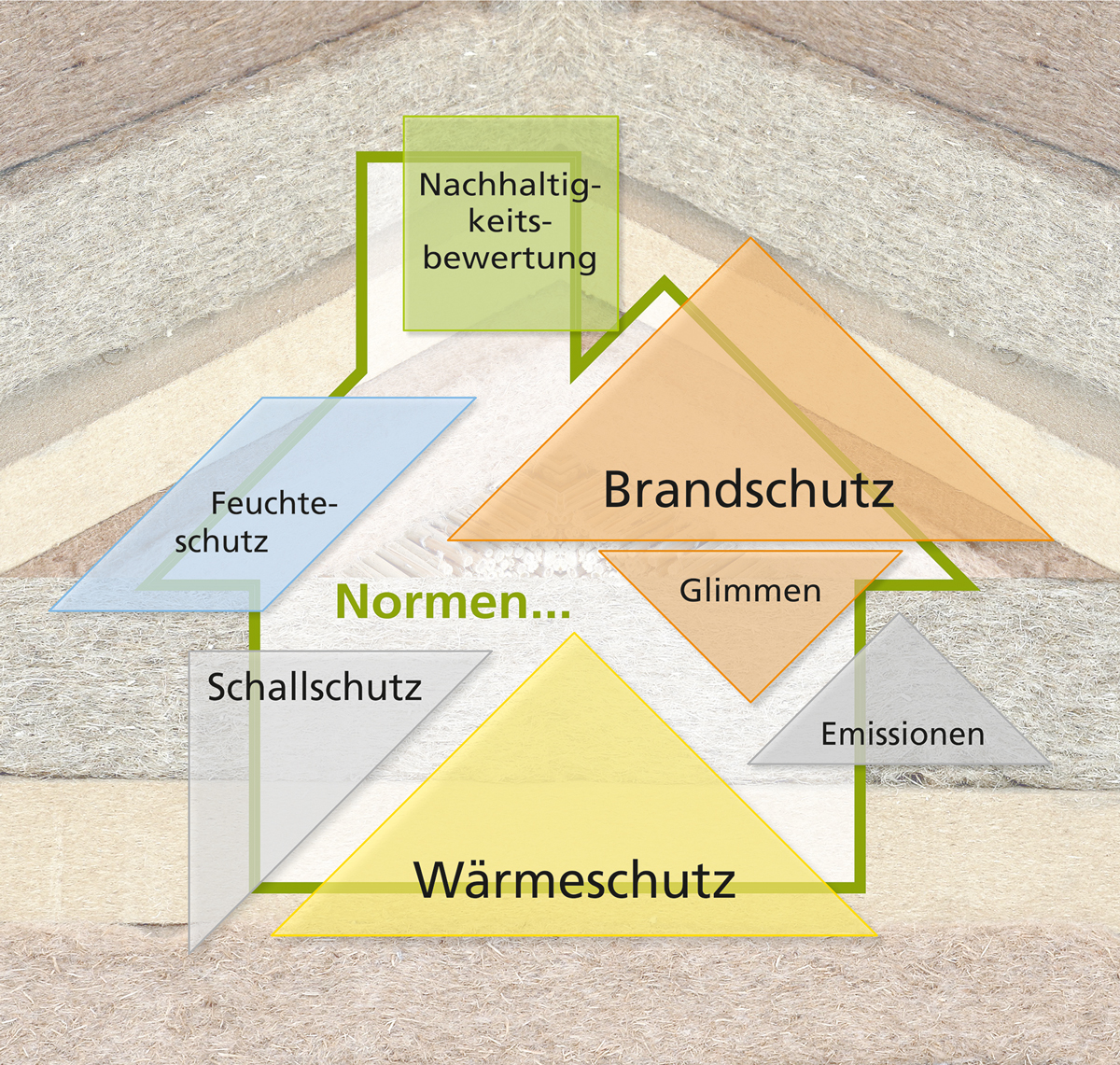Press release
Holistic research for more natural insulation materials in construction
With natural insulation materials, buildings can be constructed with calculable safety. This is the outcome of an interdisciplinary research project with 12 research partners and widespread support from industry. Under the supervision of the Fraunhofer WKI, the researchers determined the characteristic material values which will enable extensive component tests, such as in sound insulation and fire protection, to be considerably reduced in the future. On the basis of the measurement of natural insulation materials, standards and building legislation can be adapted, enabling these insulation materials to be utilized more easily in the future.
The safeguarding of resources and the use of organic, recyclable raw materials is also constantly gaining in importance within the construction industry. For this reason, there is growing interest in the utilization of insulation materials on the basis of renewable raw materials (German: nachwachsende Rohstoffe, “NawaRo”). Until now, diverse building regulations and standards have presented - and indeed still partially present - an obstacle to their use, as the implementation of NawaRo insulation materials was not taken into consideration here. As a result, extensive and complex component testing, for example, was made necessary.
Natural insulation materials can be reliably calculated
The fundamental conclusion reached by the researchers is that natural insulation materials have assured properties and that constructions can be reliably calculated and used in almost all areas of application. Using natural materials, it is possible to build calculably durable and safe buildings. Standards and building regulations can now be adapted and the green light can be given for more NawaRo insulation materials in building construction.
For the first time, the research team took a holistic view of the topic and investigated insulation materials made from renewable raw materials in six areas of work: Fire protection and glimmer behavior, sound insulation, thermal insulation, moisture protection, sustainability evaluation, and emissions.
Today, natural insulation materials are produced not only from wood and cellulose but also from plant-based raw materials such as hemp, jute, flax, straw, seagrass, meadow grass, cork and reed. Pressure-resistant panels, flexible mats, loose blow-in insulation and tamping insulation are already available on the market.
Advantages of NawaRo insulation materials
In the fire-protection and glimmer-behavior working area, the researchers were able to determine that the fire behavior of natural insulation materials differs significantly from that of petroleum-based rigid foams. Rigid foams burn extremely quickly, with very strong dark smoke formation, thereby melting and producing burning droplets. Whilst the NawaRo insulation materials investigated also burn, they do this relatively slowly, with little smoke development and do not produce burning droplets. The fire behavior of NawaRo insulation materials, particularly during the early stages of a fire, is therefore considerably more advantageous than that of rigid foams and is fundamentally calculable.
The component and material data obtained in the area of sound insulation have already been taken into account in the current revision of DIN standard 4109-33. Furthermore, calculation methods have been further developed which can considerably reduce the testing outlay in the future. Until now, insulation materials had to primarily protect against cold in winter. Due to climate change, thermal insulation in summer is gaining in importance.
In addition to thermal conductivity, the heat-storage capacity and the bulk density of insulation materials are also important. The researchers were able to determine that in this area as well, there are essentially no restrictions on the utilization of NawaRo insulation materials.
The high storage capacity of natural insulation materials has a positive effect not only on thermal insulation but also on moisture protection, particularly in wooden structures and roof construction. Whilst mineral fiber-insulation materials and petroleum-based rigid foams can absorb practically no moisture, natural insulation materials are able to buffer short-term fluctuations in moisture during the construction phase or in use without a noticeable increase in the material moisture. The construction thereby becomes much safer.
The scientists routinely investigated potential emissions and could not find any fundamental obstacles to the utilization of these materials. Furthermore, they determined data sets for the life cycle assessment, which can be entered into the database ÖKOBAUDAT of the German Federal Ministry of the Interior, Building and Community (BMI).
Research alliance with 12 partners
In addition to the Fraunhofer WKI, the following institutions participated in the research alliance:
- Institut für Holztechnologie Dresden gGmbH
- Rosenheim University of Applied Sciences (Faculty of Applied Natural Sciences and Humanities)
- Technische Universität Braunschweig (Institute of Building Materials, Concrete Construction and Fire Safety, Division of Fire Safety, and Institute of Environmental and Sustainable Chemistry)
- Magdeburg-Stendal University of Applied Sciences (Department of Water, Environment, Construction and Safety)
- National Metrology Institute of Germany (PTB)
- Leibniz Institute for Agricultural Engineering and Bioeconomy
- Papiertechnische Stiftung
- Johann Heinrich von Thünen Institute, Federal Research Institute for Rural Areas, Forestry and Fisheries (Thünen Institute for Wood Research)
- University of Stuttgart (Chair of Building Physics, Abteilung Ganzheitliche Bilanzierung – GaBi)
- Technische Universität Dresden (Institut für Holz- und Papiertechnik)
- Materialprüfungsamt Nordrhein-Westfalen (MPA NRW)
The research institutes collaborated in the project with numerous companies and associations.
The total funding for the collaborative project “More than just insulation – Additional benefits of insulation materials made from renewable raw resources (NawaRo insulation materials)” amounted to more than 4 million euros over a period of three and a half years. It was funded within the framework of the funding priority “Insulation materials from renewable raw materials” in the funding area “Material use of renewable raw materials” of the “Renewable raw materials” funding program of the German Federal Ministry of Food and Agriculture (BMEL) via the project management agency Fachagentur Nachwachsende Rohstoffe e.V. (FNR).
Last modified:
 Fraunhofer Institute for Wood Research
Fraunhofer Institute for Wood Research 